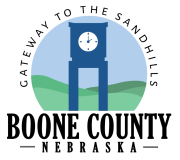A HISTORICAL SKETCH OF BOONE COUNTY
Prepared Particularly for Deposit in the Court House Cornerstone, with reference to Giving Information to Our Posterity Ages Hence.
In the spring of 1871, the first white men visited Boone County with a view to permanent residence. Previous to this, no pale-faced mortals had trod our lovely valleys, except government surveyors, adventurers or daring trappers. The first company of home-seekers that ever passed inside the present borders of our county was composed of S.D. Avery, Ralph Voorhees, Robert Hare, James Hare, and two others whose names have been forgotten.
The Nebraska legislature in 1871 passed an act providing for the organization of Boone County. Its corporate existence began July 28th of that year, upon which day John Hammond, Harvey Maricle, and S.P. Bollman were sworn in as commissioners. On the 26th day of August following these officials met at the house of Harvey Maricle and decided on the first Tuesday in January 1872, as the day on which to hold the first election. At this same meeting, Elias Atwood Sr., Edwin Dwyer and M.E. Stevens were appointed judges of election; A.W. Dyer and Sylvester Kinney clerks. At a third meeting of the county board, held at John Hammond’s home, a county seat location was selected on Section 22, Township 20 North, of Range 6 West, Mr. Maricle dissenting. At the appointed time the election was held, the votes being polled at the “Frontier House”, then the only building in “town”.
Sylvester Kinney was the first clerk of Boone County, having been so appointed by the board of commissioners. At the foregoing election county officials were selected as follows: Clerk, Sylvester Kinney; Treasurer, Albert Dresser; Sheriff, N.G. Meyers; Superintendent of public instruction, S.P. Bollman; Surveyor, S.D. Avery; Commissioners, Edward Dwyer, George C Crites and Thomas T Wilkinson; Judge, Alfred Dyer.
During the first year of county existence much difference of opinion arose as to the proper place for the permanent county seat, and the maneuvering which preceded and followed the next election held October 8, 1872, to settle the question, gives a good insight in to the native shrewdness which was characteristic of the early settlers of this section. The struggle was between Albion and Boone, each one of which places was then identified on the earliest maps by a big “P. O.” And that was all there was of them. Loran Clark, who owned the site of Albion, did not feel confident enough of victory to go to the expense of platting his town without some guaranty of its becoming the county seat. He therefore drew up a plat on paper and placed it before the people, agreeing that if they should choose his site for the county seat, that he would then survey and record as provided by law.
The election took place and Albion won by vote of 67 against 21. The Boone people, however, understanding that, legally, there was no such place as Albion, immediately had their town surveyed and named it Albion, hoping to secure the county seat on a technicality. But Mr. Clark appealed to the legislature, and Albion was finally determined to be where one now finds it on the map.
The prospects for early settlers were not flattering. On the south was the Pawnee Reservation, where thousands of Indians were assembled, and on the north a wild country where the Sioux roved unrestrained. Boone itself, the center, was a stamping-ground for both tribes and the scene of many depredations committed upon each other. But in spite of all discouragements and drawbacks incident to pioneer life, rapid progress along the line of development and “civilization” was made from the very start.
Homesteaders poured in, first by scores, then by hundreds. In a few months the best quarters of land were taken, and the tide of home-hunting humanity began to roll out of the beautiful valleys, over the hills, and into the remote sections of the county. With astonishing rapidity came the change from natural wildness to natural conditions that follow in the footsteps of man. Happy homes were constructed everywhere; towns were built as if by magic; roads laid out, bridges made, schoolhouses erected and post offices established. In short, all the conveniences of modern civilization were enjoyed, except railroad facilities. Columbus, forty-five miles from Albion, was the nearest accessible railroad point and to and from that place all goods and products were freighted by wagon, and passengers conveyed by stage.
In the early summer of 1880, the Union Pacific company completed its railroad branch to this place, which has since remained a terminus of that line. In 1884, another stub was built to Cedar Rapids, which is also a terminus, and in 1886 the Oakdale and Scribner branch of the Northwestern was constructed, giving Boone County three lines of railway—fifty-one miles in all. There are in Boone County 394,270 acres of taxable land of which 265,512 are returned by the assessors as improved. There are seven-two organized school districts in operation, four of which are designated by state authority as high schools. The actual value of real and personal property is, in the round figures, $10,000,000.00. The population is upward of 10,000. Our present county officials are: F.M. Sillik, clerk; J.F. Baird, deputy; D.J. Poynter, treasurer; W.A. Hosford, clerk of the district court; Wm Silvers, sheriff; L.W. Braman, deputy: Jos. Hamilton, judge; F.D. Williams, superintendent of public instruction; J.A. Price, attorney; Martin Patterson, surveyor; Dr. Thompson, coroner; O.M. Froistad, R.F. Williams and S.B. Morehead, commissioners.
9-14-1896—Albion Weekly News
